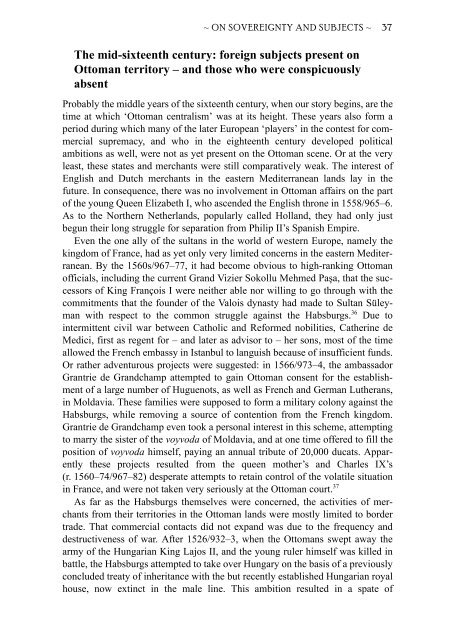The Ottoman Empire and the World Around It - Course Information
The Ottoman Empire and the World Around It - Course Information
The Ottoman Empire and the World Around It - Course Information
Create successful ePaper yourself
Turn your PDF publications into a flip-book with our unique Google optimized e-Paper software.
~ ON SOVEREIGNTY AND SUBJECTS ~ 37<br />
<strong>The</strong> mid-sixteenth century: foreign subjects present on<br />
<strong>Ottoman</strong> territory – <strong>and</strong> those who were conspicuously<br />
absent<br />
Probably <strong>the</strong> middle years of <strong>the</strong> sixteenth century, when our story begins, are <strong>the</strong><br />
time at which ‘<strong>Ottoman</strong> centralism’ was at its height. <strong>The</strong>se years also form a<br />
period during which many of <strong>the</strong> later European ‘players’ in <strong>the</strong> contest for commercial<br />
supremacy, <strong>and</strong> who in <strong>the</strong> eighteenth century developed political<br />
ambitions as well, were not as yet present on <strong>the</strong> <strong>Ottoman</strong> scene. Or at <strong>the</strong> very<br />
least, <strong>the</strong>se states <strong>and</strong> merchants were still comparatively weak. <strong>The</strong> interest of<br />
English <strong>and</strong> Dutch merchants in <strong>the</strong> eastern Mediterranean l<strong>and</strong>s lay in <strong>the</strong><br />
future. In consequence, <strong>the</strong>re was no involvement in <strong>Ottoman</strong> affairs on <strong>the</strong> part<br />
of <strong>the</strong> young Queen Elizabeth I, who ascended <strong>the</strong> English throne in 1558/965–6.<br />
As to <strong>the</strong> Nor<strong>the</strong>rn Ne<strong>the</strong>rl<strong>and</strong>s, popularly called Holl<strong>and</strong>, <strong>the</strong>y had only just<br />
begun <strong>the</strong>ir long struggle for separation from Philip II’s Spanish <strong>Empire</strong>.<br />
Even <strong>the</strong> one ally of <strong>the</strong> sultans in <strong>the</strong> world of western Europe, namely <strong>the</strong><br />
kingdom of France, had as yet only very limited concerns in <strong>the</strong> eastern Mediterranean.<br />
By <strong>the</strong> 1560s/967–77, it had become obvious to high-ranking <strong>Ottoman</strong><br />
officials, including <strong>the</strong> current Gr<strong>and</strong> Vizier Sokollu Mehmed Paşa, that <strong>the</strong> successors<br />
of King François I were nei<strong>the</strong>r able nor willing to go through with <strong>the</strong><br />
commitments that <strong>the</strong> founder of <strong>the</strong> Valois dynasty had made to Sultan Süleyman<br />
with respect to <strong>the</strong> common struggle against <strong>the</strong> Habsburgs. 36 Due to<br />
intermittent civil war between Catholic <strong>and</strong> Reformed nobilities, Ca<strong>the</strong>rine de<br />
Medici, first as regent for – <strong>and</strong> later as advisor to – her sons, most of <strong>the</strong> time<br />
allowed <strong>the</strong> French embassy in Istanbul to languish because of insufficient funds.<br />
Or ra<strong>the</strong>r adventurous projects were suggested: in 1566/973–4, <strong>the</strong> ambassador<br />
Grantrie de Gr<strong>and</strong>champ attempted to gain <strong>Ottoman</strong> consent for <strong>the</strong> establishment<br />
of a large number of Huguenots, as well as French <strong>and</strong> German Lu<strong>the</strong>rans,<br />
in Moldavia. <strong>The</strong>se families were supposed to form a military colony against <strong>the</strong><br />
Habsburgs, while removing a source of contention from <strong>the</strong> French kingdom.<br />
Grantrie de Gr<strong>and</strong>champ even took a personal interest in this scheme, attempting<br />
to marry <strong>the</strong> sister of <strong>the</strong> voyvoda of Moldavia, <strong>and</strong> at one time offered to fill <strong>the</strong><br />
position of voyvoda himself, paying an annual tribute of 20,000 ducats. Apparently<br />
<strong>the</strong>se projects resulted from <strong>the</strong> queen mo<strong>the</strong>r’s <strong>and</strong> Charles IX’s<br />
(r. 1560–74/967–82) desperate attempts to retain control of <strong>the</strong> volatile situation<br />
in France, <strong>and</strong> were not taken very seriously at <strong>the</strong> <strong>Ottoman</strong> court. 37<br />
As far as <strong>the</strong> Habsburgs <strong>the</strong>mselves were concerned, <strong>the</strong> activities of merchants<br />
from <strong>the</strong>ir territories in <strong>the</strong> <strong>Ottoman</strong> l<strong>and</strong>s were mostly limited to border<br />
trade. That commercial contacts did not exp<strong>and</strong> was due to <strong>the</strong> frequency <strong>and</strong><br />
destructiveness of war. After 1526/932–3, when <strong>the</strong> <strong>Ottoman</strong>s swept away <strong>the</strong><br />
army of <strong>the</strong> Hungarian King Lajos II, <strong>and</strong> <strong>the</strong> young ruler himself was killed in<br />
battle, <strong>the</strong> Habsburgs attempted to take over Hungary on <strong>the</strong> basis of a previously<br />
concluded treaty of inheritance with <strong>the</strong> but recently established Hungarian royal<br />
house, now extinct in <strong>the</strong> male line. This ambition resulted in a spate of


